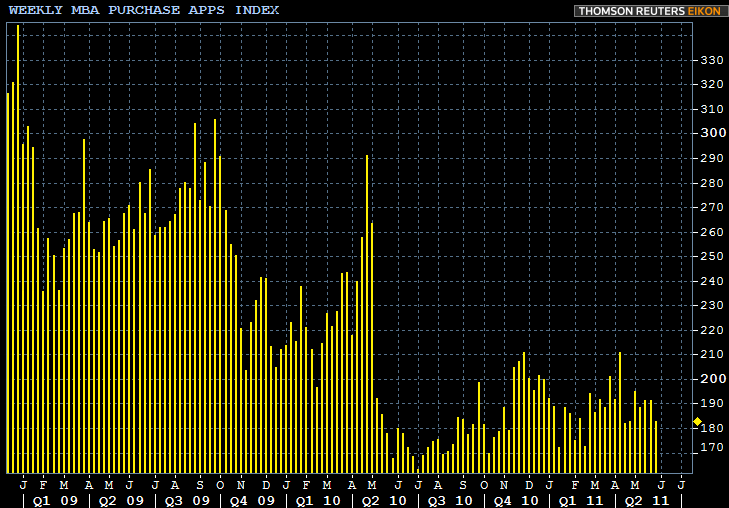The Mortgage Bankers Association (MBA) today released its Weekly Mortgage Applications Survey* for the week ending June 3, 2011.
The Refinance index seems to be stuck around the 2500 level, having risen about 500 points during the 2 month interest rate rally. The last two times mortgage rates were this low, the MBA’s Refi Index was operating almost exclusively above the 4000 mark. That was over 7 months ago. The fact that these rates haven’t motivated more refinance activity speaks to several barriers that continue to prevent borrowers from reducing their monthly payment.
The Purchases Index fell 4.4% to 182.9 from 191.4 and continues to stagnate at very low levels. In fact, there’s no evidence that they’ve broken the downtrend that began in November 2007 when the index was in the high 400’s. Since the tax credit expired, the index has been stuck between 160 and 220, languishing in a sideways.
Excerpts from the Release...
The Market Composite Index, a measure of mortgage loan application volume, decreased 0.4 percent on a seasonally adjusted basis from one week earlier. On an unadjusted basis, the Index decreased 11 percent compared with the previous week. The four week moving average fell from 3.0 to 1.0 per cent.
The adjusted Refinance Index increased 1.3 percent from the previous week (the Refinance Index is not seasonally adjusted but is adjusted for the Memorial Day holiday). The four week moving average is up 2.1 percent, lower than last week’s reading of 3.8 per cent. The refinance share of mortgage activity increased to 67.3 percent of total applications from 65.7 percent the previous week. This is the highest refinance share since January 28, 2011.

The seasonally adjusted Purchase Index decreased 4.4 percent from one week earlier. The unadjusted Purchase Index decreased 15.2 percent compared with the previous week and was 9.0 percent higher than the same week one year ago. The four week moving average is down 1.6 per cent after last week showed a 1.1 pct improvement.

The average contract interest rate for 30-year fixed-rate mortgages decreased to 4.54 percent from 4.58 percent, with points decreasing to 0.95 from 1.00 (including the origination fee) for 80 percent loan-to-value (LTV) ratio loans. This is the lowest 30-year contract rate since November 19, 2010. The effective rate also decreased from last week.
The average contract interest rate for 15-year fixed-rate mortgages decreased to 3.67 percent from 3.78 percent, with points decreasing to 1.06 from 1.07 (including the origination fee) for 80 percent LTV loans. This is the lowest 15-year contract rate since October 22, 2010. The effective rate also decreased from last week.
The adjustable-rate mortgage (ARM) share of activity decreased to 6.1 percent from 6.2 percent of total applications from the previous week.

Regarding the barriers that continue to block borrowers from reducing their monthly payments...
Two weeks ago we wrote, "Right now we're witnessing the beginnings of a mini-refinance boom in the primary mortgage market, but there has been little activity in the secondary market that would indicate increased rate locking by consumers." says MND's Managing Editor Adam Quinones. "However, if conventional 30-year rates reach 4.25%, we'd expect to see a mini-boom scenario play out. There is much stored demand in the system as many borrowers missed the boat on record low rates in October and early November. This crowd is waiting in the wings for those rates to return. Whether or not that happens is still very much up in the air"
In reaction to that comment, Ted Rood, a loan originator from MetLife Home Loans added, "One thing to consider regarding refi volume is that HUD effectively ended FHA streamlines over the course of the last year by tightening underwriting guidelines and jacking up monthly MIP fees. After the change, many existing FHA clients have been unable to meet net benefit rules, even when dropping their rate by 1% or more, since their monthly MIP would double on the new loan. So FHA clients don't get to benefit from lower rates and HUD doesn't get new upfront MIPs from existing clients with clean payment histories who want to refinance".
READ MORE: New FHA MIP Structure to Slow Streamlines
READ MORE: Rents Seen Rising as Poor Credit Hurts Homeownership Demand
READ MORE: Realtors Request Looser Credit Regs as Home Sales Decline
*The MBA's loan application survey covers over 50% of all U.S. residential mortgage loan applications taken by mortgage bankers, commercial banks, and thrifts. The data gives economists a snapshot view of consumer demand for mortgage loans. In a falling mortgage rate environment, a trend of increasing refinance applications implies consumers are seeking out lower monthly payments. If consumers are able to reduce their monthly mortgage payment and increase disposable income through refinancing, it can be a positive for the economy as a whole (may boost consumer spending. It also allows debtors to pay down personal liabilities faster. A trend of declining purchase applications implies home buyer demand is shrinking.







